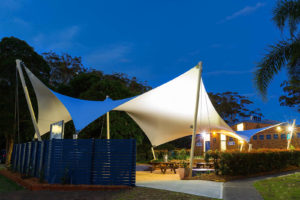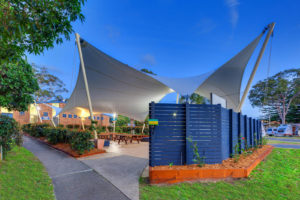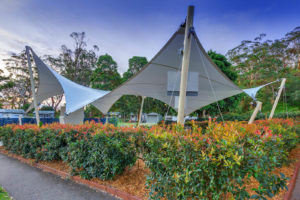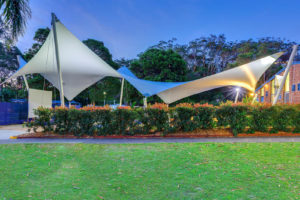 New shade sail is an opportunity to extend existing shade coverage while adding additional amenities.
New shade sail is an opportunity to extend existing shade coverage while adding additional amenities.
Halifax Holiday Park is a campground set in a natural bushland and surrounded by two calm beaches in Nelson Bay, New South Wales, Australia, a popular vacation region for many Australians as well as foreigners due to its natural beauty.
Halifax Holiday runs a number of vacation sites, and the Nelson Bay venue is situated between Shoal Bay and Little Beach, both popular vacation (“holiday” in Aussie parlance) destinations. This tensile shade canopy replaces an older one on site that was damaged during a storm. The client saw the replacement shade sail as an opportunity to extend the existing shade coverage while adding additional amenities at the grounds, primarily an enlarged movie screening area next to the site’s BBQ-entertainment common area, the focal point of the entire campgrounds covered by the original structure.
 “The area is renowned for its strong winds,” says Craig Flanagan, managing director of Shade To Order Pty Ltd., the company contracted to replace the damaged shade sail. “In addition, the client wanted something that looked good and was practical, needed to be robust in order to withstand the climatic conditions, and utilize some of the existing columns to save money.”
“The area is renowned for its strong winds,” says Craig Flanagan, managing director of Shade To Order Pty Ltd., the company contracted to replace the damaged shade sail. “In addition, the client wanted something that looked good and was practical, needed to be robust in order to withstand the climatic conditions, and utilize some of the existing columns to save money.”
The client imposed time constraints of no more than two and a half weeks from start to finish. No small order when trying to adapt the formfinding of an enlarged tensile structure. “In order to avoid ponding and to encourage surface runoff at an adequate rate,” says Flanagan, “a high degree of fabric shaping was required to complete the engineering.”
 This necessarily required adding five new columns (three high and two low) to the original five columns of the damaged structure at the end where the expanded movie viewing was to occur. “The original sail had two high columns between the place of the new high side columns and the existing low columns,” Flanagan says. “These original columns were not high enough for the increased fabric surface area and the sail would have pooled otherwise.”
This necessarily required adding five new columns (three high and two low) to the original five columns of the damaged structure at the end where the expanded movie viewing was to occur. “The original sail had two high columns between the place of the new high side columns and the existing low columns,” Flanagan says. “These original columns were not high enough for the increased fabric surface area and the sail would have pooled otherwise.”
The increased fabric area meant stepping up strength of the catenary cables and connection fittings, as well as the weight and durability of the fabric. Corner connection loads in the new canopy are about 30 percent greater than the original due to the reduced catenary cable curvature by adding length and surface. The flatter the curvature of a tensile fabric structure, the greater the end loads at connection joints.
 The new structure not only survived another storm (worst on record for the area), but the eye-catching membrane structure has become an admired feature of the grounds and neighborhood by local residents. Halifax Holiday management has even decided to begin using the image of the tensile canopy as a marketing symbol of the campground’s main attraction.
The new structure not only survived another storm (worst on record for the area), but the eye-catching membrane structure has become an admired feature of the grounds and neighborhood by local residents. Halifax Holiday management has even decided to begin using the image of the tensile canopy as a marketing symbol of the campground’s main attraction.
Bruce N. Wright, AIA, is an architect and frequent contributor to Fabric Architecture, and a consultant to architects and designers through his company Just Wright Communications.
 TEXTILES.ORG
TEXTILES.ORG


